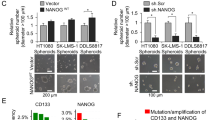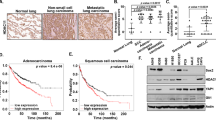Abstract
The hypothesis of cancer stem cells has been proposed to explain the therapeutic failure in a variety of cancers including lung cancers. Previously, we demonstrated acquisition of epithelial–mesenchymal transition, a feature highly reminiscent of cancer stem-like cells, in gefitinib-resistant A549 cells (A549/GR). Here, we show that A549/GR cells contain a high proportion of CXCR4+ cells that are responsible for having high potential of self-renewal activity in vitro and tumorigenicity in vivo. A549/GR cells exhibited strong sphere-forming activity and high CXCR4 expression and SDF-1α secretion compared with parent cells. Pharmacological inhibition (AMD3100) and/or siRNA transfection targeting CXCR4 significantly suppressed sphere-forming activity in A549 and A549/GR cells, and in various non-small cell lung cancer (NSCLC) cell lines. A549/GR cells showed enhanced Akt, mTOR and STAT3 (Y705) phosphorylation. Pharmacological inhibition of phosphatidyl inositol 3-kinase or transfection with wild-type PTEN suppressed phosphorylation of Akt, mTOR and STAT3 (Y705), sphere formation, and CXCR4 expression in A549/GR cells, whereas mutant PTEN enhanced these events. Inhibition of STAT3 by WP1066 or siSTAT3 significantly suppressed the sphere formation, but not CXCR4 expression, indicating that STAT3 is a downstream effector of CXCR4-mediated signaling. FACS-sorted CXCR4+ A549/GR cells formed many large spheres, had self-renewal capacity, demonstrated radiation resistance in vitro and exhibited stronger tumorigenic potential in vivo than CXCR4− cells. Lentiviral-transduction of CXCR4 enhanced sphere formation and tumorigenicity in H460 and A549 cells, whereas introduction of siCXCR4 suppressed these activities in A549/GR cells. Our data indicate that CXCR4+ NSCLC cells are strong candidates for tumorigenic stem-like cancer cells that maintain stemness through a CXCR4-medated STAT3 pathway and provide a potential therapeutic target for eliminating these malignant cells in NSCLC.
This is a preview of subscription content, access via your institution
Access options
Subscribe to this journal
Receive 50 print issues and online access
$259.00 per year
only $5.18 per issue
Buy this article
- Purchase on Springer Link
- Instant access to full article PDF
Prices may be subject to local taxes which are calculated during checkout








Similar content being viewed by others
References
Jemal A, Siegel R, Ward E, Murray T, Xu J, Smigal C et al. Cancer statistics. CA Cancer J Clin 2006; 56: 106–130.
Lam WK, Watkins DN . Lung cancer: future directions. Respirology 2007; 12: 471–477.
Jordan CT, Guzman ML, Noble M . Cancer stem cells. N Engl J Med 2006; 355: 1253–1261.
Lapidot T, Sirard C, Vormoor J, Murdoch B, Hoang T, Caceres-Cortes J et al. A cell initiating human acute myeloid leukemia after transplantation into SCID mice. Nature 1994; 367: 645–648.
Al-Hajj M, Wicha MS, Benito-Hernandez A, Morrison SJ, Clarke MF . Prospective identification of tumorigenic breast cancer cells. Proc Natl Acad Sci USA 2003; 100: 3983–3988.
Singh SK, Hawkins C, Clarke ID, Squire JA, Bayani J, Hide T et al. Identification of human brain tumour initiating cells. Nature 2004; 432: 396–401.
Ricci-Vitiani L, Lombardi DG, Pilozzi E, Biffoni M, Todaro M, Peschle C et al. Identification and expansion of human colon cancer-initiating cells. Nature 2007; 445: 111–115.
Visvader JE, Lindeman GJ . Cancer stem cells in solid tumours: accumulating evidence and unresolved questions. Nat Rev Cancer 2008; 8: 755–768.
Eramo A, Lotti F, Sette G, Pilozzi E, Biffoni M, Di Virgilio A et al. Identification and expansion of the tumorigenic lung cancer stem cell population. Cell Death Differ 2008; 15: 504–514.
Chen YC, Hsu HS, Chen YW, Tsai TH, How CK, Wang CY et al. Oct-4 expression maintained cancer stem-like properties in lung cancer-derived CD133-positive cells. PLoS One 2008; 3: e2637.
Bertolini G, Roz L, Perego P, Tortoreto M, Fontanella E, Gatti L et al. Highly tumorigenic lung cancer CD133+ cells display stemlike features and are spared by cisplatin treatment. Proc Natl Acad Sci USA 2009; 106: 16281–16286.
Ho MM, Ng AV, Lam S, Hung JY . Side population in human lung cancer cell lines and tumors is enriched with stem-like cancer cells. Cancer Res 2007; 67: 4827–4833.
Sung JM, Cho HJ, Yi H, Lee CH, Kim HS, Kim DK et al. Characterization of a stem cell population in lung cancer A549 cells. Biochem Biophys Res Commun 2008; 371: 163–167.
Levina V, Marrangoni AM, DeMarco R, Gorelik E, Lokshin AE . Drug-selected human lung cancer stem cells: cytokine network, tumorigenic and metastatic properties. PLoS One 2008; 3: e3077.
Teng Y, Wang X, Wang Y, Ma D . Wnt/beta-catenin signaling regulates cancer stem cells in lung cancer A549 cells. Biochem Biophys Res Commun 2010; 392: 373–379.
Gutova M, Najbauer J, Gevorgyan A, Metz MZ, Weng Y, Shih CC et al. Identification of uPAR-positive chemoresistant cells in small cell lung cancer. PLoS One 2007; 2: e243.
Jiang F, Qiu Q, Khanna A, Todd NW, Deepak J, Xing L et al. Aldehyde dehydrogenase 1 is a tumor stem cell-associated marker in lung cancer. Mol Cancer Res 2009; 7: 330–338.
Furusato B, Mohamed A, Uhlén M, Rhim JS . CXCR4 and cancer. Pathol Int 2010; 60: 497–505.
Kato M, Kitayama J, Kazama S, Nagawa H . Expression pattern of CXC chemokine receptor-4 is correlated with lymph node metastasis in human invasive ductal carcinoma. Breast Cancer Res 2003; 5: R144–R150.
Kim J, Takeuchi H, Lam ST, Turner RR, Wang HJ, Kuo C et al. Chemokine receptor CXCR4 expression in colorectal cancer patients increases the risk for recurrence and for poor survival. J Clin Oncol 2005; 23: 2744–2753.
Schimanski CC, Bahre R, Gockel I, Müller A, Frerichs K, Hörner V et al. Dissemination of hepatocellular carcinoma is mediated via chemokine receptor CXCR4. Br J Cancer 2006; 95: 210–217.
Na IK, Scheibenbogen C, Adam C, Stroux A, Ghadjar P, Thiel E et al. Nuclear expression of CXCR4 in tumor cells of nonsmall cell lung cancer is correlated with lymph node metastasis. Hum Pathol 2008; 39: 1751–1755.
Belperio JA, Phillips RJ, Burdick MD, Lutz M, Keane M, Strieter R . The SDF-1/CXCL 12/CXCR4 biological axis in non-small cell lung cancer metastases. Chest 2004; 125: 156S.
Su L, Zhang J, Xu H, Wang Y, Chu Y, Liu R et al. Differential expression of CXCR4 is associated with the metastatic potential of human non-small cell lung cancer cells. Clin Cancer Res 2005; 11: 8273–8280.
Liu G, Yuan X, Zeng Z, Tunici P, Ng H, Abdulkadir IR et al. Analysis of gene expression and chemoresistance of CD133+ cancer stem cells in glioblastoma. Mol Cancer 2006; 5: 67.
Hermann PC, Huber SL, Herrler T, Aicher A, Ellwart JW, Guba M et al. Distinct populations of cancer stem cells determine tumor growth and metastatic activity in human pancreatic cancer. Cell Stem Cell 2007; 1: 313–323.
Miki J, Furusato B, Li H, Gu Y, Takahashi H, Egawa S et al. Identification of putative stem cell markers, CD133 and CXCR4, in hTERT-immortalized primary nonmalignant and malignant tumor-derived human prostate epithelial cell lines and in prostate cancer specimens. Cancer Res 2007; 67: 3153–3161.
Ehtesham M, Mapara KY, Stevenson CB, Thompson RC . CXCR4 mediates the proliferation of glioblastoma progenitor cells. Cancer Lett 2009; 274: 305–312.
Krohn A, Song YH, Muehlberg F, Droll L, Beckmann C, Alt E . CXCR4 receptor positive spheroid forming cells are responsible for tumor invasion in vitro. Cancer Lett 2009; 280: 65–71.
Kalatskaya I, Berchiche YA, Gravel S, Limberg BJ, Rosenbaum JS, Heveker N . AMD3100 is a CXCR7 ligand with allosteric agonist properties. Mol Pharmacol 2009; 75: 1240–1247.
Lancaster GI, Febbraio MA . Exosome-dependent trafficking of HSP70: a novel secretory pathway for cellular stress proteins. J Biol Chem 2005; 280: 23349–23355.
Santer FR, Bacher N, Moser B, Morandell D, Ressler S, Firth SM et al. Nuclear insulin-like growth factor binding protein-3 induces apoptosis and is targeted to ubiquitin/proteasome-dependent proteolysis. Cancer Res 2006; 66: 3024–3033.
Rho JK, Choi YJ, Lee JK, Ryoo BY, Na II, Yang SH et al. Epithelial to mesenchymal transition derived from repeated exposure to gefitinib determines the sensitivity to EGFR inhibitors in A549, a non-small cell lung cancer cell line. Lung Cancer 2009; 63: 219–226.
Pfeiffer M, Hartmann TN, Leick M, Catusse J, Schmitt-Graeff A, Burger M . Alternative implicaion of CXCR4 in JAK2/STAT3 activation in small cell lung cancer. Br J Cancer 2009; 100: 1949–1956.
Nickel W . Pathways of unconventional protein secretion. Curr Opin Biotechnol 2010; 21: 621–626.
Fujiwara T, Oda K, Yokota S, Takatsuki A, Ikehara Y . Brefeldin A causes disassembly of the Golgi complex and accumulation of secretory proteins in the endoplasmic reticulum. J Biol Chem 1998; 263: 18545–18552.
Teicher BA, Fricker SP . CXCL12 (SDF-1)/CXCR4 pathway in cancer. Clin Cancer Res 2010; 6: 2927–2931.
Kijima T, Maulik G, Ma PC, Tibaldi EV, Turner RE, Rollins B et al. Regulation of cellular proliferation, cytoskeletal function, and signal transduction through CXCR4 and c-Kit in small cell lung cancer cells. Cancer Res 2002; 62: 6304–6311.
Burger M, Glodek A, Hartmann T, Schmitt-Gräff A, Silberstein LE, Fujii N et al. Functional expression of CXCR4 (CD184) on small-cell lung cancer cells mediates migration, integrin activation, and adhesion to stromal cells. Oncogene 2003; 22: 8093–8101.
Phillips RJ, Mestas J, Gharaee-Kermani M, Burdick MD, Sica A, Belperio JA et al. Epidermal growth factor and hypoxia-induced expression of CXC chemokine receptor 4 on non-small cell lung cancer cells is regulated by the phosphatidylinositol 3-kinase/PTEN/AKT/mammalian target of rapamycin signaling pathway and activation of hypoxia inducible factor-1alpha. J Biol Chem 2005; 280: 22473–22481.
Gilbert CA, Ross AH . Cancer stem cells: cell culture, markers, and targets for new therapies. J Cell Biochem 2009; 108: 1031–1038.
Park CM, Park MJ, Kwak HJ, Lee HC, Kim MS, Lee SH et al. Ionizing radiation enhances matrix metalloproteinase-2 secretion and invasion of glioma cells through Src/epidermal growth factor receptor-mediated p38/Akt and phosphatidylinositol 3-kinase/Akt signaling pathways. Cancer Res 2006; 66: 8511–8519.
Cho HH, Kyoung KM, Seo MJ, Kim YJ, Bae YC, Jung JS . Overexpression of CXCR4 increases migration and proliferation of human adipose tissue stromal cells. Stem Cells Dev 2003; 15: 853–864.
Orimo A, Gupta PB, Sgroi DC, Arenzana-Seisdedos F, Delaunay T, Naeem R et al. Stromal fibroblasts present in invasive human breast carcinomas promote tumor growth and angiogenesis through elevated SDF-1/CXCL12 secretion. Cell 2005; 121: 335–348.
Acknowledgements
This work was supported by the Mid-career Researcher Program through NRF grant (2009-0086438) and the Nuclear Research and Development Program of Korea Science and Engineering foundation funded by the Korean government (MEST) (2011-0030604).
Author information
Authors and Affiliations
Corresponding authors
Ethics declarations
Competing interests
The authors declare no conflict of interest.
Additional information
Supplementary Information accompanies the paper on the Oncogene website
Supplementary information
Rights and permissions
About this article
Cite this article
Jung, MJ., Rho, JK., Kim, YM. et al. Upregulation of CXCR4 is functionally crucial for maintenance of stemness in drug-resistant non-small cell lung cancer cells. Oncogene 32, 209–221 (2013). https://doi.org/10.1038/onc.2012.37
Received:
Revised:
Accepted:
Published:
Issue Date:
DOI: https://doi.org/10.1038/onc.2012.37
Keywords
This article is cited by
-
Multifaceted role of mTOR (mammalian target of rapamycin) signaling pathway in human health and disease
Signal Transduction and Targeted Therapy (2023)
-
CXC chemokine receptor 4 (CXCR4) blockade in cancer treatment
Journal of Cancer Research and Clinical Oncology (2023)
-
Expression profile and prognostic value of CXCR family members in head and neck squamous cell carcinoma
World Journal of Surgical Oncology (2022)
-
The long and short non-coding RNAs modulating EZH2 signaling in cancer
Journal of Hematology & Oncology (2022)
-
Breaking the crosstalk of the Cellular Tumorigenic Network by low-dose combination therapy in lung cancer patient-derived xenografts
Communications Biology (2022)



